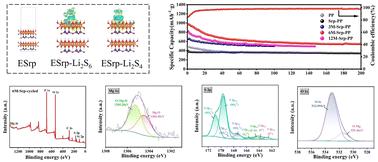Acid-etched serpentine separator with hierarchical porosity and dual-functional polysulfide regulation for high-performance lithium–sulfur batteries
IF 9.5
2区 材料科学
Q1 CHEMISTRY, PHYSICAL
引用次数: 0
Abstract
In this study, we propose the use of the natural clay mineral of serpentine as a functionalized separator coating material to address the polysulfide shuttle effect and interfacial kinetic hysteresis in lithium–sulfur batteries. Through selective magnesium removal by acid etching, the silica-oxygen skeleton of serpentine was reconfigured to form a hierarchical porous structure, and rich Si–O−/Si–OH− active sites were exposed on its surface. Under optimum acid etching conditions using 6 M hydrochloric acid, the resulting serpentine 6 M-Srp as a separator coating material can achieve significantly improved polysulfide anchoring under the synergistic effect of chemisorption and catalysis, with an Li2S deposition capacity of up to 123 mAh g−1 and a decrease in the redox peak polarization voltage by 17.8% compared with that of the PP separator. It is also confirmed that the hierarchical pores of 6 M-Srp shortened the ionic diffusion paths and synergistically optimized interfacial charge transfer, thus improving the lithium ion diffusion coefficient. Cycling tests reveal that the lithium–sulfur battery equipped with a separator coated with 6 M hydrochloric acid-treated serpentine boasts an impressive initial specific capacity of 1141 mAh g−1 at a discharge rate of 0.2C and maintains a robust specific capacity of 729 mAh g−1 even after 100 cycles. Furthermore, rate tests demonstrate the ability of the battery to sustain a specific capacity of 577 mAh g−1 under a higher current density of 1C. Notably, when the current density is reduced back to 0.2C, the specific capacity effectively recovers to 668 mAh g−1, showcasing its stability and resilience. This work provides a low-cost and high-stability separator modification strategy for the practical application of lithium–sulfur batteries.

具有分级孔隙度和双功能多硫调节的酸蚀蛇纹石分离器,用于高性能锂硫电池
在本研究中,我们提出使用天然粘土矿物蛇纹石作为功能化隔膜涂层材料来解决锂硫电池中多硫化物的穿梭效应和界面动力学滞后问题。通过酸蚀法选择性脱镁,蛇纹石的硅氧骨架被重新配置,形成层次化的多孔结构,其表面暴露出丰富的Si-O−/ Si-OH−活性位点。在最佳酸蚀条件下,使用6 M盐酸,得到的蛇纹石6 M- srp作为分离器涂层材料,在化学吸附和催化的协同作用下,可以显著改善多硫锚定,Li2S沉积容量高达123 mAh g−1,氧化还原峰极化电压比PP分离器降低了17.8%。6 M-Srp的分层孔隙缩短了离子扩散路径,协同优化了界面电荷转移,从而提高了锂离子扩散系数。循环测试表明,在放电速率为0.2C时,涂有6 M盐酸处理蛇形石的隔膜的锂硫电池具有令人印象深刻的1141 mAh g−1的初始比容量,并且即使在100次循环后仍保持729 mAh g−1的稳健比容量。此外,倍率测试表明,在1C的更高电流密度下,电池能够维持577 mAh g - 1的比容量。值得注意的是,当电流密度降低到0.2C时,比容量有效地恢复到668 mAh g−1,显示出其稳定性和弹性。本工作为锂硫电池的实际应用提供了一种低成本、高稳定性的隔膜改造策略。
本文章由计算机程序翻译,如有差异,请以英文原文为准。
求助全文
约1分钟内获得全文
求助全文
来源期刊

Journal of Materials Chemistry A
CHEMISTRY, PHYSICAL-ENERGY & FUELS
CiteScore
19.50
自引率
5.00%
发文量
1892
审稿时长
1.5 months
期刊介绍:
The Journal of Materials Chemistry A, B & C covers a wide range of high-quality studies in the field of materials chemistry, with each section focusing on specific applications of the materials studied. Journal of Materials Chemistry A emphasizes applications in energy and sustainability, including topics such as artificial photosynthesis, batteries, and fuel cells. Journal of Materials Chemistry B focuses on applications in biology and medicine, while Journal of Materials Chemistry C covers applications in optical, magnetic, and electronic devices. Example topic areas within the scope of Journal of Materials Chemistry A include catalysis, green/sustainable materials, sensors, and water treatment, among others.
 求助内容:
求助内容: 应助结果提醒方式:
应助结果提醒方式:


